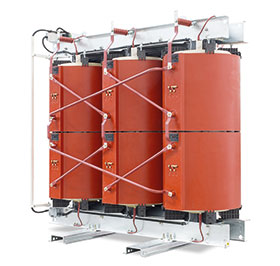Customised transformers for renewables and beyond
June 2020
Electrical Power & Protection

A focus on application engineering allows Trafo Power Solutions to supply customised dry-type transformers for a range of sectors including renewable energy.
“We begin at the proposal stage by engaging closely with the customer about the exact application and electrical load,” says David Claassen, managing director of Trafo Power Solutions. “This means that every project gets its own transformer design, so that it is fit for purpose.”
In the case of renewable energy applications, for example, there are some very specific demands that need to be accommodated. A solar power generating plant presents a situation in which a transformer will be energised from 0 to 100% on a daily basis.
“This leads to wide fluctuations in temperature inside the transformer which, in turn, causes the resin around the windings to expand and contract considerably,” says Claassen. The windings in dry-type transformers are insulated in a cast resin or epoxy material, rather than oil, and rely on air movement for cooling.
“Such fluctuations could result in the resin cracking, so the design must specify the appropriate class of insulation to cope with these conditions. We can design our windings for either Class F or Class H insulation. In addition, the mixture of the resin is specially formulated to accommodate the duty cycle specific to renewable energy applications.”
The standard design – using Class F – can deal with temperatures up to 155°C. For many of Trafo Power Solutions’ low-voltage and high-voltage installations around Africa, the design includes a resin mix to Class H specifications. This gives it the capacity to withstand temperatures of up to 180°C.
Another aspect that needs to be considered for renewable energy applications is the non-linear load that inverters add to the mix. The transformers need to be designed with a K-factor much higher than used for standard distribution type loads as well, as the addition of an electrostatic shield between the primary and secondary windings to eliminate potentially damaging leakage currents.
Claassen notes that dry-type transformers are being increasingly specified for demanding applications such as renewable energy plants, instead of conventional oil transformers.
“With an oil-cooled unit, the temperature fluctuation arising from these rapid and regular energising and de-energising cycles brings its own challenges,” he adds. “In particular, it causes more gases to be emitted within the transformer tank, which leads to a variety of problems.”
The cast resin material used in Trafo’s dry-type transformers meets the specifications of the International Electrotechnical Commission (IEC) for fire class F1. The units therefore present minimal fire risk, allowing them to be used indoors safely, and without environmental protection like bund walls for potential oil spills.
Claassen says dry-type distribution transformers are fast becoming a more suitable alternative to oil transformers, especially in the distribution power range between 50 kVA and 10 MVA, although Trafo Power Solutions is able to supply dry type transformers up to a power rating of 25 MVA
Further reading:
Rail electrification and EV solutions for integrated transport systems
Electrical Power & Protection
A comprehensive range of solutions for rail electrification and electric vehicles is available from leading technology provider ABB, contributing significantly to integrated and sustainable transport systems.
Read more...
PPS delivers containerised distribution board for Western Cape hybrid power project
Electrical Power & Protection
South African electrical enclosure specialist Power Process Systems has successfully completed the design, fabrication and commissioning of a 4000 A containerised distribution board for a wind/PV solar hybrid renewable energy project on a site in the Western Cape.
Read more...
The choice of a thermal carrier is critical for optimal processing
Electrical Power & Protection
Historically steam, fuelled by coal, has been the most prevalent thermal carrier in South African industry. However, times are changing, with the manufacturing and processing sector needing to review the energy reticulation systems and thermal carriers currently in use.
Read more...
ABB’s blueprint for a net zero future
Electrical Power & Protection
ABB’s Mission to Zero is a strategic initiative aimed at achieving a sustainable future characterised by zero emissions, zero accidents and zero waste.
Read more...
How South Africa’s transformer manufacturing industry can fill a gaping infrastructure gap
ACTOM Electrical Machines
Electrical Power & Protection
South Africa’s energy transition is accelerating the demand for power transformers. However, this shift toward renewable energy is exposing a critical infrastructure gap: a severe shortage of transformers.
Read more...
General-purpose 350 W AC-DC power supply
Electrical Power & Protection
The TDK-Lambda GUS350 series of compact single-output general-purpose power supplies addresses the need for an economically priced product while maintaining reliability and quality.
Read more...
Ground-breaking battery tester
Comtest
Electrical Power & Protection
Midtronics offers the proven MVT handheld battery tester. This revolutionary tool, powered by MDX-AI, is set to redefine the standards of battery diagnostics and testing in the automotive industry.
Read more...
Green hydrogen could be the missing link in powering the future of technology
Electrical Power & Protection
Green hydrogen has numerous applications across multiple industries. It also has the potential to provide a clean energy source to power future technology, with far-reaching implications for both industry and society.
Read more...
Energy audits pave the pathway to sustainability and savings
Schneider Electric South Africa
Electrical Power & Protection
Energy audits serve as essential tools for businesses looking to reduce costs and meet environmental targets. By analysing energy consumption across systems such as lighting, HVAC, ICT and water infrastructure, audits identify inefficiencies and quantify carbon footprints, enabling data-driven decisions for operational and financial optimisation.
Read more...
Passive fire protection for lithium-ion battery risks
Electrical Power & Protection
In response to the growing threat posed by lithium-ion (Li-ion) battery fires, a breakthrough passive fire protection solution is now available in South Africa.
Read more...


